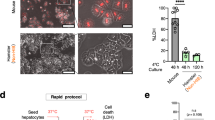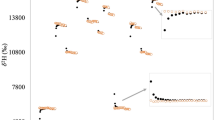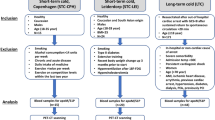Abstract
LIPID metabolism in mammals has been widely investigated with reference to cold acclimation and hibernation. In this laboratory, work on lipid metabolism is hamsters during cold exposure and hibernation has been focused on rates of lipid synthesis or utilization in tissues in vitro. This communication is concerned with measurement of the circulating total lipid in the intact animal. Analyses were performed on blood from, cold-exposed and hibernating golden hamsters (Mesocricetus auratus). A similar series of analyses were performed on white Wistar rats to provide comparison with a non-hibernating mammal. Blood samples were taken from animals kept at room temperature as control, and kept in the cold (5° ± 1° C) for 48 h, 3 weeks or 6–8 weeks. Samples were also taken from hamsters in hibernation, arousing from hibernation (cheek pouch temperature 18°–20° C) and immediately after the animals regained full consciousness and normal temperature. The animals were stunned by a sharp blow on the head, except those in hibernation. Approximately 2 c.c. of blood were withdrawn by cardiac puncture. After removal of the needle the syringe was discharged into a centrifuge tube and the sample allowed to clot. The samples were centrifuged and the serum removed by suction. The serum was then analysed for total lipid by a colorimetric method employing Sudan black B, described by Swahn1. The samples were compared with a standard of corn oil in ethanol. The concentrations were calculated as mg total lipid/100 ml. of serum. The results are shown in Fig. 1.
This is a preview of subscription content, access via your institution
Access options
Subscribe to this journal
Receive 51 print issues and online access
$199.00 per year
only $3.90 per issue
Buy this article
- Purchase on Springer Link
- Instant access to full article PDF
Prices may be subject to local taxes which are calculated during checkout
Similar content being viewed by others
References
Swahn, Bengt, Scand. J. Clin. Lab. Invest., 5, supp. 9 (1953).
Deane, H. W., and Lyman, C. P., Endocrinology, 55, 300 (1954).
Denyes, Arliss, and Horwood, Robert H., Canad. J. Biochem. Physiol., 38, 1479 (1960).
Denyes, Arliss, and Carter, Joan D., Nature, 190, 450 (1961).
Hannon, John P., and Larson, Anna M., Amer. J. Physiol., 203, 1055 (1962).
Hannon, J. P., and Young, D. W., Amer. J. Physiol., 197, 1008 (1959).
Author information
Authors and Affiliations
Rights and permissions
About this article
Cite this article
DENYES, A., BAUMBER, J. Comparison of Serum Total Lipid during Cold Exposure in Hibernating and Non-hibernating Mammals. Nature 206, 1050–1051 (1965). https://doi.org/10.1038/2061050b0
Issue Date:
DOI: https://doi.org/10.1038/2061050b0
Comments
By submitting a comment you agree to abide by our Terms and Community Guidelines. If you find something abusive or that does not comply with our terms or guidelines please flag it as inappropriate.



